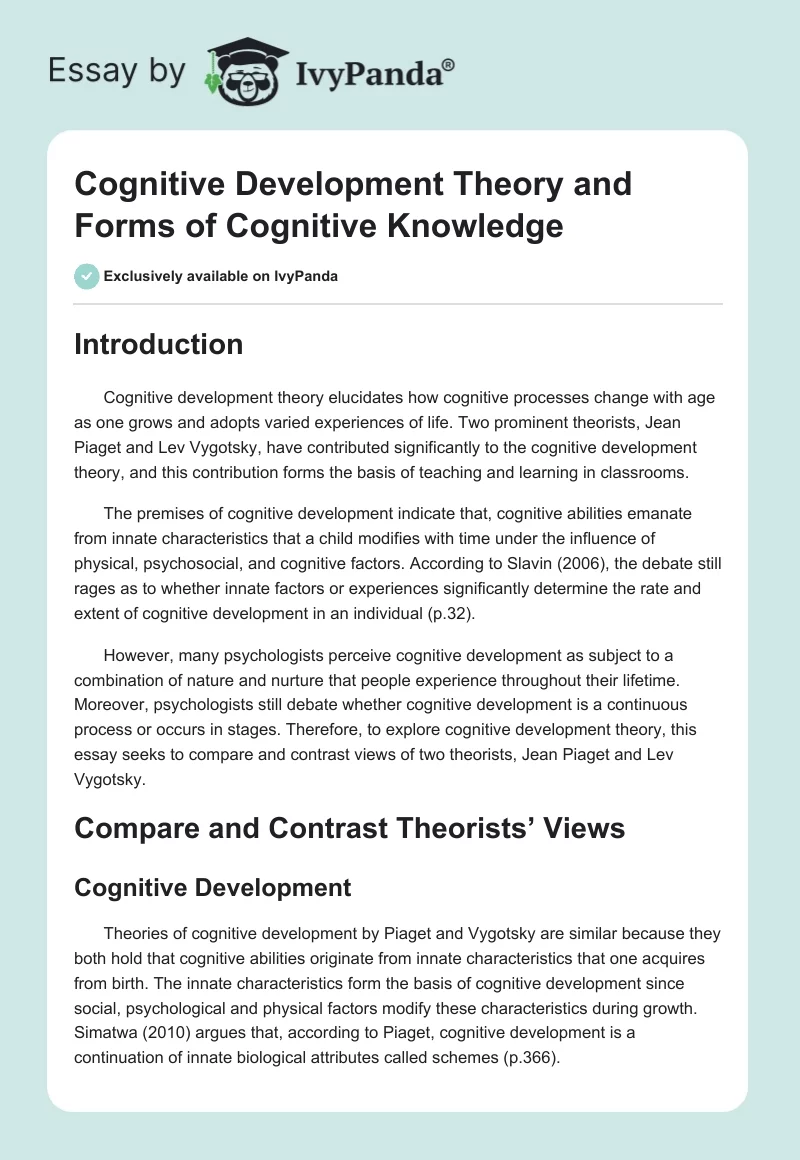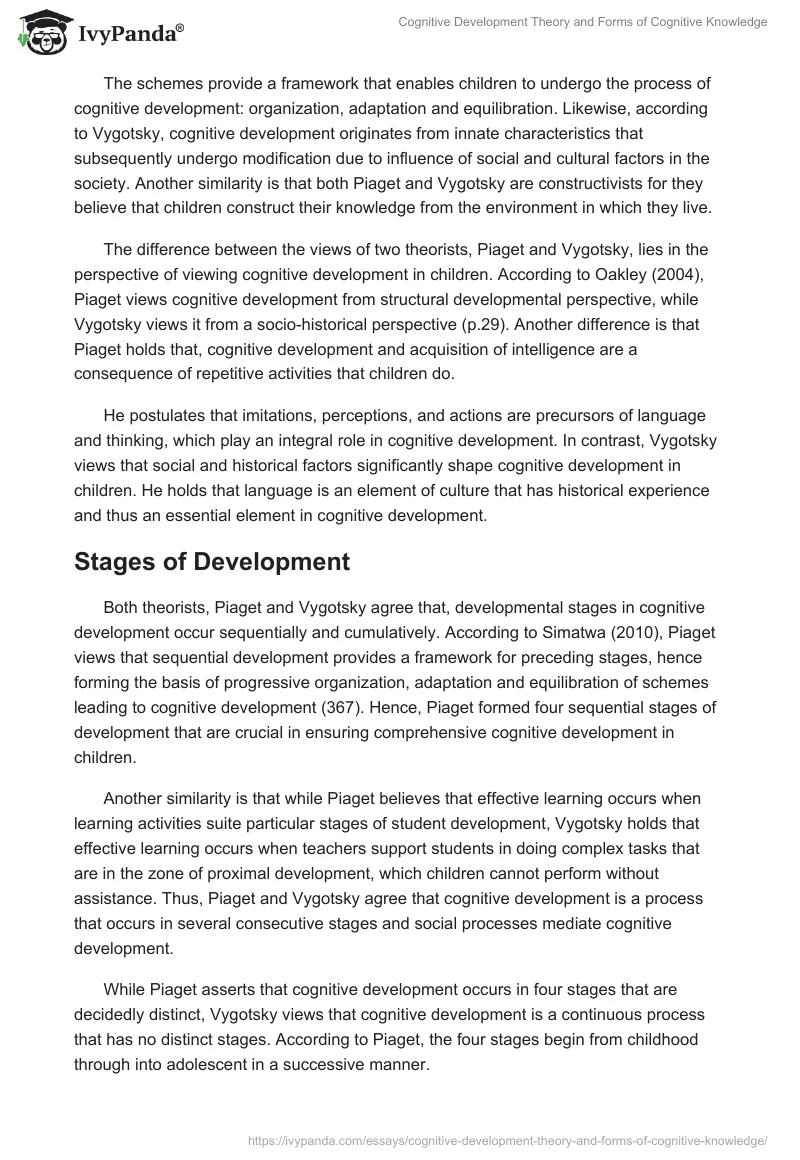Introduction
Cognitive development theory elucidates how cognitive processes change with age as one grows and adopts varied experiences of life. Two prominent theorists, Jean Piaget and Lev Vygotsky, have contributed significantly to the cognitive development theory, and this contribution forms the basis of teaching and learning in classrooms.
The premises of cognitive development indicate that, cognitive abilities emanate from innate characteristics that a child modifies with time under the influence of physical, psychosocial, and cognitive factors. According to Slavin (2006), the debate still rages as to whether innate factors or experiences significantly determine the rate and extent of cognitive development in an individual (p.32).
However, many psychologists perceive cognitive development as subject to a combination of nature and nurture that people experience throughout their lifetime. Moreover, psychologists still debate whether cognitive development is a continuous process or occurs in stages. Therefore, to explore cognitive development theory, this essay seeks to compare and contrast views of two theorists, Jean Piaget and Lev Vygotsky.
Compare and Contrast Theorists’ Views
Cognitive Development
Theories of cognitive development by Piaget and Vygotsky are similar because they both hold that cognitive abilities originate from innate characteristics that one acquires from birth. The innate characteristics form the basis of cognitive development since social, psychological and physical factors modify these characteristics during growth. Simatwa (2010) argues that, according to Piaget, cognitive development is a continuation of innate biological attributes called schemes (p.366).
The schemes provide a framework that enables children to undergo the process of cognitive development: organization, adaptation and equilibration. Likewise, according to Vygotsky, cognitive development originates from innate characteristics that subsequently undergo modification due to influence of social and cultural factors in the society. Another similarity is that both Piaget and Vygotsky are constructivists for they believe that children construct their knowledge from the environment in which they live.
The difference between the views of two theorists, Piaget and Vygotsky, lies in the perspective of viewing cognitive development in children. According to Oakley (2004), Piaget views cognitive development from structural developmental perspective, while Vygotsky views it from a socio-historical perspective (p.29). Another difference is that Piaget holds that, cognitive development and acquisition of intelligence are a consequence of repetitive activities that children do.
He postulates that imitations, perceptions, and actions are precursors of language and thinking, which play an integral role in cognitive development. In contrast, Vygotsky views that social and historical factors significantly shape cognitive development in children. He holds that language is an element of culture that has historical experience and thus an essential element in cognitive development.
Stages of Development
Both theorists, Piaget and Vygotsky agree that, developmental stages in cognitive development occur sequentially and cumulatively. According to Simatwa (2010), Piaget views that sequential development provides a framework for preceding stages, hence forming the basis of progressive organization, adaptation and equilibration of schemes leading to cognitive development (367). Hence, Piaget formed four sequential stages of development that are crucial in ensuring comprehensive cognitive development in children.
Another similarity is that while Piaget believes that effective learning occurs when learning activities suite particular stages of student development, Vygotsky holds that effective learning occurs when teachers support students in doing complex tasks that are in the zone of proximal development, which children cannot perform without assistance. Thus, Piaget and Vygotsky agree that cognitive development is a process that occurs in several consecutive stages and social processes mediate cognitive development.
While Piaget asserts that cognitive development occurs in four stages that are decidedly distinct, Vygotsky views that cognitive development is a continuous process that has no distinct stages. According to Piaget, the four stages begin from childhood through into adolescent in a successive manner.
In contrast, according to Oakley (2004), Vygotsky argues that one cannot adequately define cognitive development using stages because it is a complex process, which is under the influence of social and cultural factors in an environment (p.36). Hence, Vygotsky did not provide distinct stages of cognitive development, unlike Piaget. Another difference is that while Piaget believes that learning is in tandem with stages of development, Vygotsky perceives that learning precedes cognitive development.
Applications of Theorists’ Views
Cognitive development views of Piaget and Vygotsky are similar in that, they both believe that teaching style and environment play an integral role in shaping innate schemes that children have from birth. It, therefore, means that teachers should consider employing effective teaching styles and creating learner friendly environment as an application of cognitive development theory in enhancing learning in children.
Slavin (2006) argues that, for effective learning to occur in the classroom, teachers need to ensure that education curriculum, learning environment, teaching materials and instructions meet social, physical, emotional and cognitive needs of students at various ages (p.41). Even though children go through the same developmental stages, cognitive development occurs at different rates among students, hence need consideration.
Although Piaget and Vygotsky views of cognitive development are applicable in teaching and learning, they have contrasting application in the classroom. Simatwa (2010) argues that, Piaget views require that teaching methodology, learning activities and materials should suit specific cognitive developmental stages of students (370).
Thus, contrasting application of cognitive development theory is that, Piaget views are applicable in designing and customizing teaching curricula that fits various stages of learning, while Vygotsky views are applicable in creating a social and cultural environment that promotes teaching and learning in children.
Unlike Piaget views of cognitive development, according to Slavin (2006), Vygotsky concepts of zone of proximal development and scaffolding require teachers to aid children in learning complex tasks (p.47). Thus, teachers need to give out complex tasks and aid students by giving hints to enable them learn effectively.
Conclusion
Cognitive development theory has not only contributed to understanding of cognitive development in children, but has also led to promotion of teaching and learning in the classroom. Piaget and Vygotsky are two theorists who have elucidated cognitive development from structural and socio-historical perspectives respectively.
Despite their contrast in the elucidation of cognitive development, the views of both theorists are helpful in designing and customizing teaching curricula as well as creating appropriate learning environment that enhances performance of students.
References
Oakley, L. (2004) Cognitive Development. London: Routledge.
Simatwa, E. (2010). Piaget’s Theory of Intellectual Development and Its Implication for Instructional Management of Pre-Secondary School Level. Educational Research and Reviews, 5(5), 366-371.
Slavin, R. (2006). Educational Psychology: Theory and Practice (8th Edition). Boston, MA: Pearson.


